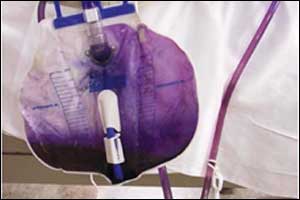- Home
- Editorial
- News
- Practice Guidelines
- Anesthesiology Guidelines
- Cancer Guidelines
- Cardiac Sciences Guidelines
- Critical Care Guidelines
- Dentistry Guidelines
- Dermatology Guidelines
- Diabetes and Endo Guidelines
- Diagnostics Guidelines
- ENT Guidelines
- Featured Practice Guidelines
- Gastroenterology Guidelines
- Geriatrics Guidelines
- Medicine Guidelines
- Nephrology Guidelines
- Neurosciences Guidelines
- Obs and Gynae Guidelines
- Ophthalmology Guidelines
- Orthopaedics Guidelines
- Paediatrics Guidelines
- Psychiatry Guidelines
- Pulmonology Guidelines
- Radiology Guidelines
- Surgery Guidelines
- Urology Guidelines
Purple urine in torsades de pointes: NEJM case report

A recently published intriguing and rare case in the The New England Journal of Medicine has cited a case wherein a man with end-stage renal disease and dementia displayed purple urine following the incidence of torsades de pointes.
The case is of a 76-year-old male with dementia and end-stage renal disease who was undergoing hemodialysis was admitted to the hospital after a syncopal episode that occurred during dialysis. Torsades de pointes was noted on telemetry monitoring. When a urinary catheter was placed, purple urine was drained.
The patient had no fever, lower urinary tract symptoms, or leukocytosis. The urinalysis showed a pH of 9.0 and bacteriuria but no hematuria or pyuria. The urine culture showed 105 colony-forming units or more per milliliter for both Pseudomonas aeruginosa and enterococcus species. Over the next 3 days, the urine gradually became yellow and clear, in the absence of antibiotic treatment.
Purple discoloration can occur in alkaline urine as a result of the degradation of indoxyl sulfate (indican), a metabolite of dietary tryptophan, into indigo (which is blue) and indirubin (which is red) by bacteria such as Providencia stuartii, Klebsiella pneumoniae, P. aeruginosa, Escherichia coli, and enterococcus species. The clinical course is benign, and the urine typically clears with a resolution of the bacteriuria and acidification of the urine.
This patient had no further episodes of torsades de pointes and returned to the nursing home in stable condition.
For further information click on the link: https://www.nejm.org/doi/full/10.1056/NEJMicm061573

Disclaimer: This site is primarily intended for healthcare professionals. Any content/information on this website does not replace the advice of medical and/or health professionals and should not be construed as medical/diagnostic advice/endorsement or prescription. Use of this site is subject to our terms of use, privacy policy, advertisement policy. © 2020 Minerva Medical Treatment Pvt Ltd